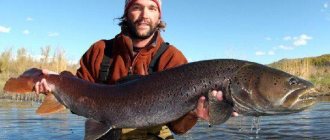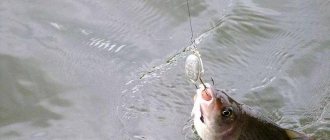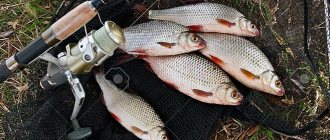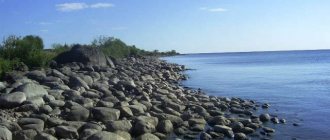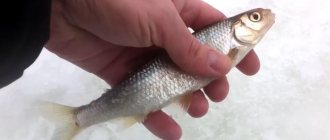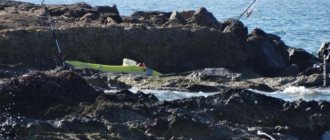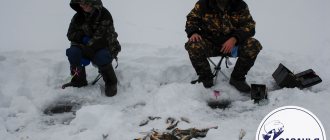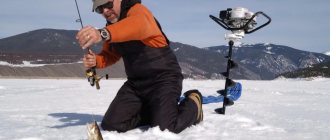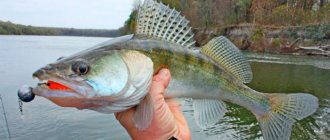Fishing for taimen is shrouded in an aura of mystery, adventure and anticipation of a trophy that is mighty in strength and size, and this is actually confirmed by the fishing practice of some lucky people who have experienced all the delights of this kind of trip. One of the brightest representatives of salmon fish is not such a common object of fishing. Due to the sharp decline in the population of this species that began in the middle of the last century, fishing for taimen is limited, and the fish itself is included in the country’s Red Book and is under the vigilant protection of the state.
Only some regions of the country provide vouchers for organizing taimen fishing, by purchasing which an angler can legitimately count on catching the fish of his dreams. But in addition to the opportunity to obtain permits, you need to understand that the trip will take a long time and you will have to seriously prepare for living in the difficult conditions of the taiga and have reliable fishing equipment with a supply of bait attractive to fish. The following article will be presented to the reader about planning a fishing session the purpose of which is taimen.
Where is taimen found in Russia?
The habitat of our today's hero extends from the Trans-Urals to the Far East. The taimen fish is found in the basins of large Siberian and Far Eastern rivers, among which the Lena, Yenisei, Amur, and Lake Baikal stand out. The further north the region, the higher the number of this representative of salmon fish, and it is larger in size. Southern Siberia, the Sayan Mountains and Altai, once famous for their catches, have now lost their leading position in the number of taimen, and meeting them in the rivers of these regions has become a great rarity and incredible luck for a fisherman.
The fish avoids industrial areas near large cities and looks for secluded areas for living in calmer and cleaner waters, avoiding polluted reservoirs with low oxygen concentrations in the water. You can find a large population of the Red Book fish outside of untouched areas, remote from civilization, where, in principle, fishing tours are organized by a few agencies specializing in providing this type of tourist services.
Fishing in the Krasnoyarsk Territory
The first place where fishermen stop is the vicinity of the Krasnoyarsk reservoir. Green shores, beautiful nature, clean water, but fishing prefers other places in solitude. Quiet places where there are fewer fishermen and larger fish are more attractive. On the reservoir itself you can fish from a boat, using light-colored baits, and using a fishing rod - donka.
Wolf Lake is very popular for its clear water and large specimens of fish. You need to cast your fishing rod to the bottom, where large fish are hiding in the holes. You can also fish from the shore, but you need to be careful with your gear; coastal areas are heavily overgrown with grass and thin fishing line can easily get tangled and break. The depth of the lake reaches 6 meters, the bottom is sandy with islands of shells, but the shores are flat and fishing near the shore is a pleasure.
Fish habits
Fishing for taimen will not be successful without basic knowledge of the behavior and nutrition of the fish. This one of the largest representatives of the salmon species differs in habits from its relatives and prefers to live in fresh waters, never going into the seas and oceans. Only the Sakhalin branch of the population stands out from the general series, living in the Sea of Japan and falling under the definition of anadromous type. A clear predator that feeds on animal food, at the beginning of its long life cycle it actively eats insects and aquatic larvae, moving with age to small and medium-sized fish, and also does not disdain a meal of small animals that fall into the water, such as mice and even squirrels.
The fish has a mouth with small teeth and is similar in body shape to other salmon representatives. The size of taimen is impressive. A fish weighing 5–10 kg is considered a fry. But individuals weighing 20-30 kg are already fully mature specimens worthy of the title of trophy. Among local old-timers who specialize in catching taimen, stories of catching fish weighing 50–60 kg and 1.5 meters long are persistently cultivated, although the real limit of the growth potential of the largest representative of the salmon species for ichthyology still remains an unexplored corner of its life.
Promising search places
Fishing for taimen is promising in the middle and lower parts of rivers at moderate currents. The fish rise to the upper reaches during the spawning period, during which they practically do not feed, so their captures at such points in the reservoir are quite rare and are more likely to be periodic or random. Regarding the depths, it is worth noting that taimen can stand both in shallow water and in deep areas. The main thing is that the parking area is covered with a bottom anomaly, dead wood or stones that change the speed of water flow.
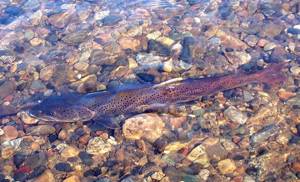
Important! It is at the boundaries of whirlpools, depth changes, in areas of stones protruding from the water, ridges of underwater boulders, and the confluence of small rivers into a large watercourse that predator sites are found.
The main food source for taimen are smaller salmon fish such as whitefish and grayling. By their massive accumulation in the river area, one can judge the giant’s ambush places. The small predator stays near ambush sites in a flock of 7–10 individuals, approximately equal in size. Particularly large predators occupy the area purely for themselves, hunting alone in selected underwater areas. Near the riffles on the shallows, not far from sandy or pebble spits, despite even the low water level, you can count on catching a solid trophy, absolutely not paying attention to this factor.
Fishing Features
Many amateurs believe that only large spoons should be used to catch this predator, but this is not entirely correct. Quite often, taimen swallows the bait, but the fisherman thinks that it is caught on a stone or log. And while he is thinking about how he will free the stuck spoon, he feels a sudden sharp jerk. Sometimes especially large specimens simply go to a deep place to lie at the bottom.
Taimen often uses the technique of releasing the spoon, which is popularly called a “candle”. Having made a sharp jerk, this fish, jumping out of the water, opens its mouth very wide and shakes its head. The fisherman should not loosen the fishing line at this time, although this is quite difficult, especially if the prey moves in his direction before the “candle”.
The coolest temperament is found in individuals that reach a weight of eight to twelve kilograms. From the outside, fighting them is very similar to a real fight, which requires incredible physical effort from a person. Large specimens are very exhausting for the fisherman, since sometimes the fight drags on for a long time.
Fishing for taimen has one more feature: if the adults leave the spoon, then in the near future they will no longer bite on this bait.
When to catch
The fish is active throughout the year, and if you know where to stay under the ice, fishing for taimen in winter can bring positive results. But according to the season, the most active period is identified after the spawning of fish. This usually happens at the beginning of the calendar summer. In June, after spawning, predators begin to fatten up, bringing their nutrition to a glutton that lasts during the first two weeks of summer. Then the intensity of the bites subsides until mid-autumn, when the second wave of zhora, preceding wintering, is noticed.
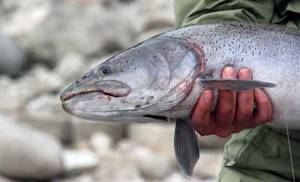
Important! During the zhor season, taimen feed throughout the day, despite the night time.
In normal mode, the fish is active from dawn until 9–10 o’clock and at sunset from dusk until complete darkness. As a rule, the effective season for catching taimen is considered to be the beginning of summer and the period of time until freeze-up, when the fish, which have gained calories, exhibit noticeably less food activity. In cloudy weather, fish take bait more readily and can feed throughout the day. The bright sun is not conducive to biting, forcing the giants to retreat into the shade and wait for more suitable conditions for feeding. In the spring, with the arrival of muddy water, even a hungry predator after winter and preparing to spawn is rarely caught.
Tackle for catching taimen
All tackle used in practice for taimen are distinguished by increased strength characteristics. The most popular and widespread fishing for predators is using a spinning rod. With a powerful spinning rod, equipped with a power reel with a well-functioning friction brake, you can count on a successful outcome in the fight against a twenty-kilogram trophy. For these purposes, forms are selected 2.5-3 meters long, with dough from 35 to 50 grams. The most practical gear is medium action, which allows you to find the optimal parameters for bait control and compensate for overloads when playing large fish in rapids. For spinning, choose a power inertialess mechanism of 4500–6000 units or a multiplier version of the mechanism close to these characteristics, equipped with a monofilament line that better withstands the requirements of fishing on abrasive bottom grounds.
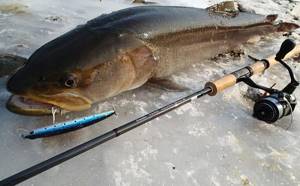
Fishing for taimen is much less common with fly fishing gear. The parameters of the whip are chosen according to the size of the fish, and therefore, they are equipped with the most massive gear of class 10–12, supplementing them with special medium-sized inertial reels with an adjustable ratchet brake. In specific places it is possible to use such gear as a boat and even a live bait float rod. When equipping installations, attention is paid to the thickness of the fishing line, which can withstand excessive loads and effectively resist abrasion on pebbles and rocky bottom soils. Hooks sharpened to perfection will help you reliably hook and hold massive fish that are frisky while playing, preventing them from getting away.
Lures for taimen
Taimen bite both artificial and live bait. Based on the most common fishing methods, which are spinning and fly fishing, in practice artificial imitations are more applicable and convenient. In spinning fishing, oscillating and rotating spoons are most common. Large and heavy pike spoons also work well on the taiga giant. Among the spinners, they select numbers 5–6 according to the Mepps classification, using both the Aglia and Comet types, depending on the preferences of the predator at a given moment of fishing. Spinners are used in classic colors of silver, brass and copper, selecting baits depending on the lighting - the brighter the light, the more aggressive the spinner should be in flashing and vice versa.

Recently, the popularity of minnow-type wobblers has been growing, capable of operating without failures in strong currents and having their own game. In some conditions, especially often in shallow waters, poppers are used for spinning hunting. Effective are artificial baits that resemble mice or rats in appearance, which, due to their realistic resemblance to food items, are successful in targeted fishing for trophy fish. Fly fishing uses streamers and large wet and dry flies, nymphs, bug imitations and a variety of grubs. When fishing with live bait, whitefish, small grayling or dace are used in rigs, because this is a natural and well-known food for the red fisher.
Meet the winter float tackle
A winter float fishing rod consists of a short winter fishing rod, the length and material of which are not significant. In its simplest form, it is simply a fishing rod, consisting of a whip and a reel handle. You can also use a reel rod, but it must be equipped with a stand, at least in the form of a flyer.
Filly is a fishing rod shape traditional for winter float fishing. Such gear was used back in the century before last and was described by a number of naturalists and researchers, for example, Sabaneev and Aksakov. The advantage of a fishing rod over a fishing rod and reel is that you can measure the amount of fishing line on it in advance without removing the depth on the float, and reel it in at the end of fishing on a reel. Then, when you come to the same place, you don’t need to set the depth; you just need to unwind the fishing rod and immediately start fishing.
It should be noted here that the most convenient are fillies with two reels - one for storing a supply of fishing line, the second for reeling in equipment at the end of fishing. Unfortunately, these are rarely found on sale and fishermen usually make them themselves. There are no special requirements for the material of the whip - the main thing is that it is not too soft and allows hooking. He does not participate in landing the fish - it is pulled out by the fishing line with his hands.
The disadvantage of the filly is that the line on the reel itself can freeze - this is bad when you often move from place to place. However, in winter float fishing you have to do this infrequently; they mostly sit on the same holes. And unwinding frozen fishing line is not too much of a problem - it comes off quite easily, cutting through the ice. By the way, about the fishing line. When winter fishing with a float, it is not at all necessary to use ultra-thin line, which jig anglers often use. If the game is played here, it is usually in the form of a single toss of the nozzle followed by a smooth lowering and will not be hidden by the neutral buoyancy of the fishing line. A fishing line with a thickness of 0.14 and even 0.2 mm would be completely “legal”, although the latter may already alert the fish and will require the use of a leash. However, when catching rotan and some other fish with a float, the thickness of the fishing line does not matter. The author usually uses 0.14, which was purchased with a large supply, both in current and in still water.
The hook is selected according to the type of fish and bait. For example, when fishing for crucian carp, it is better to put a larger hook - a small one simply does not cut through its thick lip. The same applies to rotans. For the latter, it is better to use a large round jig even with a float due to the specific nature of the bite - it usually stands in place for a long time, swallowing the bait, the float moves only at the very beginning of the bite, and then freezes, as a result the fish can swallow the hook deeply, causing it to bite when If you are fishing with two or three rods, you can skip it. And with a jig, the float will float up, and it’s immediately clear what needs to be pulled out.
Sometimes they use a tackle with two hooks. The author believes that historically the same Sabaneev describes a similar equipment when fishing for ruff, however, in modern conditions it is easier to have one more fishing rod than to sculpt more hooks on them. However, when exploring a reservoir, it is possible to use two hooks, when it is necessary to test two different baits; multi-hook tackle can also be used for fishing in the horizons at great depths.
The float and weight are the main elements of the gear. In the classic version, a float is placed, then there is one weight and below it, 10-15 cm, a hook with a nozzle. The load is taken such that it is slightly larger than the carrying capacity of the float, that is, it should sink it. The float in this case is located just below the crust of ice in the hole, it is visible, it does not freeze into the ice. There is no need to overload the tackle, as it will be difficult to see the bites on the rise. The load should only slightly exceed the carrying capacity of the float, taking into account the weight of the hook and nozzle, and the weight of the jig instead of the hook, if one is used.
The winter float must be attached to the fishing line at one lower point. It must have a movable hinge mount or a movable upper part - the fish bite is determined by its movement. This can be seen as the movement of a float under water to the side. If the float is fixed at two points, or a fishing line is passed through its body, then the bite will be difficult to see - its movement up and down is not as noticeable as wagging to the side for an angler looking down.
For the same purpose, the top of the float is often made flat and beveled - it will turn the float during a “crushing” bite. However, even cheap store-bought floats with a round tip are good - they work fine if they are attached only at the bottom point to the fishing line. A beginner should not use floats that are too complex - it is better to start with simple single-body floats, although they come in two or more parts connected by a hinge.
Read: Pike fishing in winter
It should be painted only in light colors - white or yellow. They are best visible on the dark surface of the water in the hole, even in bright light. As a last resort, you can sit with your back to the sun so that the fisherman’s shadow covers the holes and you can clearly see the floats. It should be borne in mind that not only the top, but also the side of the float should be clearly visible. In this case, the top is made a little darker than the sidewall, since when biting the sidewall shows, and this should be noticeable.
How to catch taimen
Once again, we emphasize that fishing for taimen is limited by law and the fisherman bears considerable responsibility for the future of this fish . Therefore, regardless of the fishing methods, it is reasonable to conduct production according to the catch-and-release principle, without causing harm to the population of the rare species and promoting its further survival in natural conditions. Despite the fact that spinning takes a leading position in taimen fishing trips as the main fishing tool, from region to region one can observe local approaches to catching the predator. In the continuation of the article, we will consider a number of technologies for obtaining this coveted trophy, starting with the most popular and moving on to more exotic fishing options.
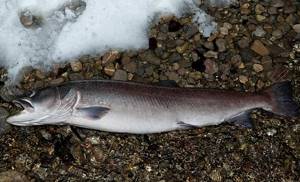
How to catch taimen using a spinning rod
Fishing for taimen with a spinning rod can be carried out in two directions: coastal hunting and hunting while rafting down the river on a motor boat. Coastal hunting in often impassable places is difficult and does not always provide the spinner with the opportunity to fish promising areas, being content with fishing in small areas approaching the water. The boat significantly expands the possibilities, which often becomes the key to success. On a motor they rise against the current, catching promising points by feeding bait against the flow of water. The predator is not very timid and, confident in its invulnerability, rarely leaves the hunting grounds due to the noise of the engine. A spinner can be successful even if his camouflage is not particularly thorough.
The main thing is to correctly determine where the fish are staying and lead the bait close to the bottom, allowing them to play through the flow of water. Large individuals prefer massive and heavy baits. Small spinners will fall prey to lenok or perch, as well as undergrowth like a couple of kilos of timefish. In riffles and shallow waters they fish from the surface, floating imitations of mice and feeding poppers to the predator. In water areas with pike, metal leashes are installed in the rig, otherwise the spinning angler faces frequent cuts from the bait of the catfish, which competes with other predators.
Fly fishing for taimen
You can fly fish for taimen in the fall and summer using an artificial mouse. They go out for fly fishing with mice closer to dusk and at night. The delicate tackle catches large, highly resistant trophies, so the equipment uses long backing, which allows the fish to escape a couple of tens of meters. In addition to mice and popper-type wobblers, streamers identical in appearance to salmon fishing, intruders, artificial leeches, fly wobblers and fly spinners are suitable for fly fishing. Taimen prefer fly baits in natural dark colors.
Fishing in other ways
Of the alternative tackles, the most popular is a boat, released with bait in the form of an artificial fly, an oscillating spoon or a soft mouse. Local residents, with centuries of accumulated experience, successfully hunt the giant using props and hooks of various designs. As bait, these specific tackles are equipped with live bait or a bunch of large worms, feeding the rigs into the fishing zones tested by the fisherman. Often, float-based live bait fishing rods are used for these purposes. On lakes and large rivers, catching the predator by trolling is quite successful. A well-chosen working wobbler for taimen is led over promising sites for the predator, picking up especially large active individuals that react to the sharp play of the bait.
Fishing for taimen
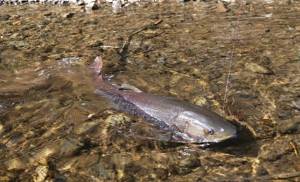
The predator is quite aggressive when playing, moreover, large fish are incredibly strong and can easily crush flimsy tackle, not forgiving of delays in reeling in a loose cord, gaining some freedom of action and maneuver for a jerk. After poking the bait, you should make a test mark, securely place the trophy on the hooks, and immediately begin pumping out the fish. It is important not to allow the predator to retreat to cover, which is often a nearby dead tree or underwater rock ridge, from where it will be almost impossible to remove densely entrenched taimen.
Often, a powerful candle at the initial stage of fishing allows the fish to spit out the hooks, so you should constantly keep the line tight, gradually tiring the fish, while simultaneously working with the rod and reel to pump out and reel in the released line. Despite its massive size, taimen is a rather delicate fish, sensitive to oxygen starvation and microtrauma from a hook, and even more so from a hook. It is recommended to hold the caught fish for as little time as possible, take a couple of wonderful photos and release it back into the river stream.
Sections
Probably everyone, even the least romantic person, has a crystal dream. I don't know about you, but I dream big. Both about the realizable and the unrealizable. Although I still try to be realistic in this. I also have my deepest dreams, which, like good wine, become more desirable and brighter from year to year. There have already been moments in my life when the brightest and even seemingly unlikely to be fulfilled desires came true. Their implementation made me momentarily the happiest person, making me experience a feeling of incredible intoxicating euphoria. These are exactly the emotions I experienced quite recently, when I put a bold tick next to the “Taimen” item on my wish list. You probably have a question: “Why exactly taimen?! What's so special about it?" Before this trip to the Primorsky Territory, I myself could not formulate the answer, but this fish, like a magnet, was strongly attracted to me. Now, after meeting the owner of the taiga rivers, I can give a detailed answer, which can be understood by reading my entire story.
Taimen is the largest representative of the salmon family on the planet. Currently, ichthyologists distinguish two types of taimen: the Siberian taimen, which inhabits the basins of the great Siberian rivers, and the Danube salmon, which lives mainly in the mountain rivers of the Danube basin in central and eastern Europe. Both species are capable of growing to very large sizes, becoming top predators in their respective rivers. There is a third variety - Sakhalin taimen, which differs from the other two in its lifestyle, being a migratory form. The body shape and size of the Sakhalin taimen is similar to both the Siberian and the European ones, but, nevertheless, ichthyologists tend to classify the Sakhalin taimen as a separate species of anadromous salmon.
Even as a child, I remember I was fascinated by the stories of my grandfather, who grew up on the Yenisei: “We’re going with the guys to the river to swim,” he said, “we look - a man is coming towards us from the river and dragging a raincoat. And when we got closer to it, we were stupefied - it was not a tent at all, but a huge taimen with a black back, which the guy held over his shoulder under the gill cover, and the tail stretched along the ground! Later, when I became actively interested in spinning, I began to re-read periodicals with stories about taiga fishing and review stories about taimen expeditions. In general, this topic interested me very much. I set myself a goal: to be sure to visit the “correct” river, where these fascinating giants live.
The choice of one of the rivers near the Sikhote-Alin ridge, in Primorye, was not accidental. This is one of the few places where the habitats of large taimen can be reached by river without a helicopter transfer. Of course, such a lift by boat takes much more time, but it saves a lot on the budget.

The journey by car from Ussuriysk took almost a day, and here we are on the river bank.

We reload our luggage from the trunks into two boats and begin our ascent early in the morning of the new day.
Everything is unusual for us here. It’s hard to imagine that tigers live in the forest along the banks of the river! If you believe the words of our local guide Sergei, there are a lot of big cats in these places - much more than official statistics. But, unfortunately, or perhaps fortunately, we did not meet any tigers. Although, I must admit, I really want to see this “kitty” in the wild.
I was already here last year. Then we did not ascend the river to the upper reaches, as we are planning now, but remained in the middle reaches. But I liked the fishing there so much that, without hesitation, I planned a trip for this year with the goal of catching not only the ubiquitous lenok, but also taimen (Sikhote-Alin: fishing in tiger land Part 1 and Part 2). As I now understand, we were unlucky with water that year: the level compared to the current one was a meter higher, and the transparency was extremely low. Now I see a completely different river: transparent, rolling, with a large number of stone spits, which were then flooded.

We climbed almost without stopping, occasionally mooring to the shore to change the next fuel tank. After lunch, when most of the journey had already been completed, one of the boats in which Vadim Grushko and Alexey Ivashkov were traveling went uphill for about 20 minutes. We kept in touch by radio, so we always knew each other's positions. On one of the reaches they decided to wait for us. Ivashkov, of course, could not resist the temptation: he took out a tube, took out a Pontoon21 Stylo SL732L-T rod with a test weight of up to 10.5 g, put an old “best-of-life” Certate'10 2500 reel on it and tied on a Pontoon21 TB spinner Trait #1. In this form, the tackle is ideal for quickly catching lenok. While we were overcoming rapids and creases, the helmsman of the first boat suggested rafting along the long stretch of logs and branches piled up near the shore. Alexey happily agreed. With one of the precise casts, Ivashkov placed the spinner under the snags... The small “spinner” of the first number attracted the attention of some huge fish - it was him! Taimen!
Alexey, realizing the low probability of defeating his opponent, holding such a light tackle in his hands, said to Vadim and Sergei: “There is no chance...” But Sergei, starting the engine, replied: “You will take it!” This is where the experience of the helmsman was decisive: carefully backing up and moving the fish away from the rubble, Sergei approached the rocky spit, where it was much easier for Alexey to cope with the giant.
On the tenth attempt, Ivashkov brought taimen into shallow water and recorded the catch by taking the fish by the tail - eat!

Incredible! With such light tackle he managed to defeat taimen, whose weight was 11 kg!

Of course, after the memorable photo, the taimen was released. We arrived when it was all over... Although, no, Ivashkov’s eyes continued to “burn,” and he himself was in a half-drunk state, not believing what happened right now. By the way, this is his first fish weighing over ten kilograms caught with a spinning rod!
This episode did not in any way affect the schedule of our ascent along the river. Late in the evening, almost at sunset, we landed on the spit, where we set up a tent camp.

On the morning of a new day, we get into the boat and set off upstream.

The river here has become more distinctly mountainous: the current is stronger, there are more sharp turns and creases.

Sergei says that few people go up here: the river is complex and not everyone knows the passages along narrow channels that allow you to bypass blind creases. As a rule, they are used only by local guides.

That is why there are still a lot of fish here. However, it cannot be said that people are a rare guest here. Fishermen purposefully go to these places, but what’s good is that most of them are “head-to-head” and are not involved in outright fishing. And, what surprised me most of all, according to Sergei, in these places taimen are caught much more often on the “catch and release” principle than downstream, where the fish are “strangled” mercilessly and all in a row. His words were confirmed later; I will talk about this in more detail below.
After walking up for about two hours, we find ourselves in a narrow channel, where we begin fishing with light tackle for lenka, of which there are so many here that schools of fairly large fish (1-2.5 kg) are visible everywhere in the clear water. However, due to the warm water and brightly shining sun, the lenkas were in no hurry to react to our baits. Of course, we managed to find the keys to the intractable fish, but I will tell you about this in a separate publication.
There are also a lot of grayling in the river. Although it is not large, it is very contrasting and beautiful.
However, I note that in the by-catch with lenkas, in addition to grayling, medium-sized (up to 1.5 kg) timefish were always present. During the day, each of us managed to catch up to a dozen of them with light tackle!
This number of juveniles is very pleasing - it means that there is a stable breeding stock in the river, on which the entire population rests.
Of course, you can purposefully catch large taimen from the shore. Only this can take a lot of time, therefore, it is much easier, if you have a boat, to find fish by rafting. Here we calculated everything very clearly: from the morning until about three o’clock in the afternoon we catch lenok from the shore, swimming from one interesting place to another, and in the evening, continuing to catch, we begin to raft in the direction of the camp.
Today is our orientation day. We experimented a lot with gear, selecting the most optimal options for lenka. Well, at the appointed hour we got into the boat and began the rafting.
Considering that the river is mostly not wide, I decided on the gear during the ascent. Taking into account last year's experience and assessing the fishing conditions, the choice fell on the following set: Megabass Blizzard Manipulator BMS702MMHF rod with test weight up to 24 g, Daiwa Exist'15 2510RPE-H reel, Pontoon21 Eighteria 20 Lb cord.

Pike in these places are found exclusively in oxbow lakes; you shouldn’t expect a bite on the main channel, so it’s enough to use fluorocarbon as a leash. The power of my cord is 20 Lb., based on this, I took a “flur” with a power of 16 Lb. The use of a fluorocarbon leader is not caused by the fact that taimen will “bite” the line. There are a lot of logs, stones and branches in the river, with which the cord, every now and then, in contact under load, is deformed and quickly loses strength. A half-meter leash made of fluorocarbon, known for its resistance to abrasion, allows you to minimize the likelihood of chafing the “braid”.
Let's go rafting. The current is very fast, the boat is carried so quickly that in many promising places it is possible to make just one cast and a very fast retrieve. In such conditions, there is no chance to fish a promising area in detail: the shore rushes by like a fast train. Therefore, everything must be done very accurately, quickly and accurately. Involuntarily, the emphasis is placed on a quick search for active fish.
Counting on catching an adult taimen, I decided not to waste time on trifles and set exclusively large baits. I took with me the most suitable large minnow wobblers that work steadily in strong currents. The first bait offered to taimen was my favorite OSP Asura Rudra 130SP. Of course, taking into account the expected loads of the resisting “monster”, I replaced the original tees with more powerful Owner ST-56 #4.
Initially, we didn’t have much of an understanding of where to look for taimen. Drawing an analogy with fishing for brook trout in similar conditions, I began to “read” the shore and look for places where, as I think, a large specimen of the “brook” would most likely stay. On Caucasian rivers, any hole is a “home” for large trout: it is both a shelter in case of danger and an excellent place for an ambush. My guesses regarding taimen are confirmed by Ivashkov’s case yesterday - the bite occurred right at the crease. But I didn’t have to wait long for additional confirmation: after another cast under the snags, when the wobbler barely touched the surface of the water, a healthy fish suddenly jumped out, but missed the “Rudra”. This episode once again convinced us that it is the creases that need to be given the most attention.
Around the next bend, the river approaches a steep bank, in front of which there is a section of calm water with good depth. I stand ready and, after waiting for the optimal moment to cast, I place the bait under the rock and begin a quick jerking retrieve. At the moment when a powerful stream has already taken the boat below this bay, in the clear water I see the side of a large fish flashing and, at the same moment, a bite... Hooking... A jerk under a very strong load and a cliff! But why didn’t the cord hold up?! The reason for this is complex: the bite occurred at the moment when the boat, carried away by a strong current, began to move away from the bay, and the friction was configured so as to fend off jerks under lighter loads. The cord itself was not in my favor; I have been using it all season, so signs of wear were already visible to the naked eye. Usually, when fishing for pike, I allow the cord to be in such a state, since I know the wear patterns of the Eighteria, especially since this model is one of my main ones. The conclusion is made - tomorrow I will install a more powerful fence.
To get bandaged, I ask Sergei to land on the shore. I didn’t take a spare spool with a more powerful cord with me on the water, so now I’ll fish more carefully and loosen the clutch. Having cut off the most worn four-meter piece of “braid”, I tie on a “shock leader” made of fluorocarbon and put on another cool large minnow Pontoon21 Cablista 125SP-SMR. I haven’t used this wobbler in such a strong current yet, but I know for sure that it holds steady in the stream.
We move away from the shore and raft to the next creek nearby. I choose the most promising place for casting, place the bait under the snags and, having started a quick jerking retrieve, I notice that a taimen about a meter long has attached itself to the wobbler. He escorted the wobbler almost to the boat and, finally, reluctantly butted the bait, but did not catch it. This inspired me - the wobbler works! And when retrieving, the Cablista 125’s action is so active that the flickering sides of the wobbler are visible even at a great distance.
During today's rafting, we already had many chances to catch a standing taimen, but, alas, so far everything is off the mark... Alexey Ivashkov decided not to repeat himself with me on baits and, according to my recommendation, installed a smaller wobbler - DUO Realis Jerkbait 100SP. This minnow has hydrodynamic properties very similar to wobblers of the very popular trout-salmon series DUO Ryuki , so it is very suitable for strong flows of mountain rivers. But the taimen are still ignoring this bait, but the lenkas, often large, do not allow passage!
Cablista 125 is probably too large for lenok, since I have had their bites many times less often. But that's good. A larger bait allows us to cut off the bites of lenks, which we had already caught in the first half of the day, and concentrate exclusively on the taimen.
The sun is nearing sunset. It is this period of time that is considered the best: activity increases, fish that stayed hidden during the day go out hunting.
Having reached the next crease, I saw an interesting place: a local crevice into which a strong stream flows, and immediately behind it lies a huge tree root. I cast under this root, start retrieving and, at the same moment, I see taimen, which “flew out” from the depths towards the bait. I stop the wiring, the fish stands in front of the wobbler... A couple of seconds and, unable to bear it, opens its white mouth and grabs my “Kablista”! Eat! Taimen on hooks! The first moments of resistance, when the fish was actively flashing its sides, it seemed to me that this taimen was simply unrealistic in size!

Sergei started the engine and, slowly, headed for the nearest spit. When the depth became no more than half a meter, I jumped overboard and began to carefully fish for the trophy. The emotions are simply indescribable!
Only one phrase was spinning in my head: “Don’t get off!”

The tackle in my hands was appropriate, so I managed to tire the fish quite quickly.

In shallow water, it was not difficult to defeat a large fish, and soon, taking the taimen by the tail, I recorded the catch!

Until now I have never even seen such a taimen! Of course, pictures from the Internet don’t count. This is my record at the moment!

I try to be careful with taimen, so I don’t take it to the shore, where it could get injured on the rocks.

The weight of this fish is exactly 10 kg.
Remember, I quoted Sergei’s words that it is customary to release taimen here? So, this fish I caught had been caught at least twice before me! This is evidenced by two protracted cuts on the adipose fin.

Before releasing, many fishermen make an incision in the fin with a knife, which is a mark indicating the capture of this fish. Apparently I am the third angler to take a photo with this beauty.

However, I did not make any marks on the taimen’s body. But, for sure, this fish will be caught by someone else.

After releasing the mighty fish, it took me a while to normalize my emotions. However, dusk is already approaching and you need to go to the camp, which is located two dozen kilometers downstream. Local guides freely travel along the river even at night, but we don’t need such extreme sports. Tomorrow we will continue fishing, and today’s reconnaissance day was just great.
To be continued.
